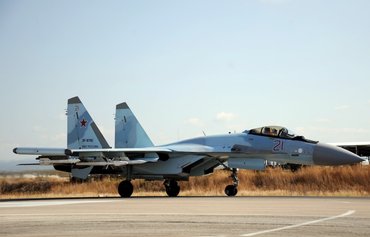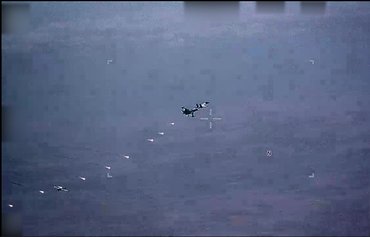US Air Force F-22 Raptors have deployed to the Middle East in the wake of "increasingly unsafe and unprofessional behaviour by Russian aircraft in the region", the US military said Wednesday (June 14).
The stealth fighter-bombers from the 94th Fighter Squadron are part of "a multifaceted show of US support and capability", US Central Command (CENTCOM) said in a statement announcing the deployment.
They demonstrate the ability of the United States "to re-posture forces and deliver overwhelming power at a moment's notice", it said.
The F-22 Raptors will integrate with international coalition forces on the ground and in the air, CENTCOM said, noting that the deployment is a demonstration of the US commitment to long-term peace and stability in the region.
![F-22 Raptors in Syria in a photo posted on June 14. [CENTCOM]](/cnmi_di/images/2023/06/21/42671-fymvvbaxoayul-h-600_384.jpg)
F-22 Raptors in Syria in a photo posted on June 14. [CENTCOM]

A screenshot from a CENTCOM video from April 18 shows a Russian fighter that came within 2,000 feet of a US aircraft.
"Russian Forces' unsafe and unprofessional behaviour is not what we expect from a professional air force," CENTCOM commander Gen. Michael "Erik" Kurilla said.
"Their regular violation of agreed upon airspace deconfliction measures increases the risk of escalation or miscalculation," he added. "Alongside our partners and allies, we are committed to improving the security and stability in the region."
This is the first time the United States has deployed F-22s to the Middle East since responding to drone attacks on the United Arab Emirates (UAE) last year, Al-Monitor reported.
The US Department of Defence (Pentagon) approved the deployment in order to avert a potentially more serious confrontation, officials told the outlet.
The highly manoeuvrable planes join other American combat aircraft already based in the region, including F-16s and A-10s, they said.
The 94th Fighter Squadron performed the first operational deployment of the F-22 to the Middle East in 2011.
The Raptors are widely hailed as the best fifth-generation fighter in the world for their combined stealth, aerodynamic performance and mission systems.
They continue to demonstrate air superiority and lethality in the fight against the "Islamic State of Iraq and Syria" (ISIS), according to a 94th Fighter Squadron fact sheet.
Uptick in Russian aggression
In March, Kurilla said the United States had seen an uptick in aggressive and unprofessional behaviour from Russian pilots in Syrian airspace following several recent incidents.
"They fly over our bases with ground attack aircraft with weapons on them in an attempt to try to be provocative," Kurilla said during a March 16 congressional hearing.
A video released by CENTCOM from April 2 shows a Russian Su-35 fighter jet conducting an "unsafe and unprofessional" intercept of a US F-16 fighter jet in coalition-controlled airspace over Syria.
A second video from April 18 shows a Russian fighter that violated coalition airspace over Syria and came within 2,000 feet of a US aircraft.
This follows a March 14 incident where Russian jets collided with a US drone over the Black Sea.
And on February 12 and 13, "three US Navy P-8A aircraft experienced unprofessional intercepts by Russian aircraft" in international airspace over the Mediterranean Sea, the Pentagon said in a statement.
"While no one was hurt, interactions such as these could result in miscalculations and mistakes that lead to more dangerous outcomes," Pentagon spokesman Capt. Mike Kafka said at the time.
The United States contacted Russian officials through diplomatic channels to express concerns, he said.
"The United States will continue to operate safely, professionally and consistent with international law in international waters and airspace," Kafka said. "We expect Russia to do the same."
In April 2020, in two separate incidents, Russian Su-35s intercepted a US Navy P-8A over the Mediterranean Sea, conducting high-speed inverted manoeuvres and coming within 7.5 metres of the US surveillance aircraft, the Navy said.
"The manoeuvres were unsafe and jeopardised the safety of the pilots and crew," it said.
A month later, the Navy said two Russian Su-35 aircraft intercepted another Navy P-8A over the Mediterranean, in an encounter that lasted 65 minutes.
Deconfliction agreement in Syria
On February 15, according to a CNN report, US fighter jets and other international coalition aircraft escorted three Russian aircraft in eastern Syria when the Russians flew into coalition-restricted airspace.
A Russian cargo aircraft, accompanied by two Tu-22 Backfire bombers, flew across Iraq into the Eastern Syria "security zone" without giving sufficient advance notification to the coalition, according to US officials.
Flying over the security zone requires prior notification of the US forces.
In 2015, the United States and Russia signed a "deconfliction" agreement to co-ordinate airspace over Syria and avoid midair incidents.
The agreement also stipulates a specific protocol to resolve any disagreement or conflict by top military officers from both sides who are peers in military rank.
Per the agreement, the parties are to guarantee their movements do not clash in terms of timing and location and are to work together to ensure aircraft are not targeted by defence systems of either side or that of the Syrian regime.
US pilots say the Russians are prone to ignoring the conventions of air safety, the Wall Street Journal reported in 2017.

![A US F-22 Raptor conducts a combat air patrol mission over an undisclosed location in Southwest Asia on September 13, 2019. [US Air Force]](/cnmi_di/images/2023/06/21/42670-f22-raptor-flight-600_384.jpg)






